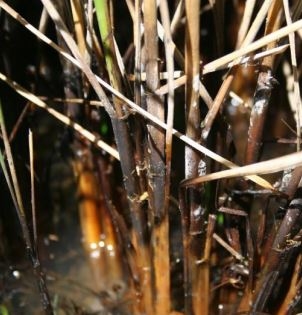In general, rice diseases are not a big problem in California. However, in some fields, disease pressure can be high and can result in yield losses. One disease that can be found in practically every rice field is stem rot. This fungus causes the tillers to rot at the water level and, when severe, it causes blanking and lodging. In our fungicide trials, we rate the severity of stem rot at drain time using a scale that goes from 0 to 4, where 0 is no disease and 4 is when the tiller is completely rotted. In my experience, when a field approaches an average severity of 2, a yield loss occurs. The problem with this rating system is that it is very time consuming. However, there is a good relationship between severity and incidence, the percentage of tillers that have stem rot symptoms. As severity increases, so does incidence, and when severity reaches a level of 2, incidence is 100%. This means that if you monitor your field at drain time and find that in a random sample of tillers all show symptoms of stem rot, the field is likely at severity level 2 or above and a yield loss may occur.
While this method of evaluating the level of stem rot in your field may help you explain blanking, lodging, and lower yields, it does not help you with the decision to take any corrective action that year. At drain time, it is too late to use a fungicide. I'm currently working on a project trying to determine if we can evaluate stem rot earlier, around the boot stage. In this way, a grower or PCA can decide if a fungicide treatment for stem rot is really needed before reaching the heading stage. Last year was the first year of this project. More years will be needed to provide a recommendation.
A project I have conducted for the past two years looked at the differences between varieties in their susceptibility to stem rot. All our varieties are susceptible, but there are some differences. Varieties with a short cycle, like S-102, CM-101, or M-105 are more susceptible than varieties with longer cycles, like M-209 and M-211. This information might help growers and PCAs improve their disease management program.
As you know, azoxystrobin (the active ingredient in Quadris) is the main fungicide used in rice in California. Many trials have confirmed that we can obtain stem rot severity reduction when applying this fungicide at the late boot to early heading stage. We also tested applying the fungicide at propanil time, but we did not see any benefits of this application timing. In the variety testing mentioned above, stem rot severity was reduced 20-30% when azoxystrobin was applied at early heading (when the first few heads were visible above the canopy). In 2021 this disease reduction resulted on a 4% yield increase. While in 2022 there was no yield increase, we did see increased milling quality in fungicide treated plots.
